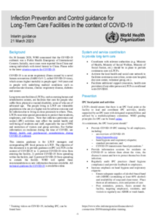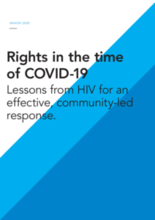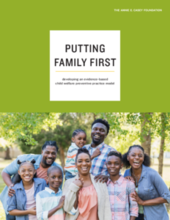Demographic Data
|
Sources: World Bank, UNDP, UNAIDS, DHS 2013 |
Displaying 4521 - 4530 of 14393
This interim guidance is for Long-term care facility (LTCF) managers and corresponding infection prevention and control (IPC) focal persons in LTCF. The objective of this document is to provide guidance on IPC in LTCFs in the context of COVID-19 to 1) prevent COVID-19-virus from entering the facility, 2) prevent COVID-19 from spreading within the facility, and 3) prevent COVID-19 from spreading to outside the facility.
This guidance is to support the management of children and young people living in children's homes, residential special schools and colleges, and other residential facilities during the COVID-19 crisis.
"Hundreds of thousands of vulnerable U.S. children could face a heightened risk of abuse and neglect as coronavirus-related school closures keep them at home and away from the nation’s biggest group of hotline tipsters: educators," says this article from USA Today.
This article from NPR accompanies a brief radio segment highlighting the difficulties faced by families with children in foster care during the COVID-19 pandemic, particularly the suspension of in-person visits between parents and their children.
UNAIDS has consulted with the HIV and Human Rights Reference Group, experts from civil society, academia and public health and other United Nations agencies to identify key learnings from the HIV response that are critical in ensuring an evidence-informed and effective response to an epidemic.
This paper aims to provide a better understanding of the impact of parental migration on the welfare of left-behind children in the Philippines so that policies can be devised to support them.
Preliminary findings from studies using abbreviated formats of Parent-Child Interaction Therapy (PCIT) suggest effectiveness of such adaptations in reducing externalizing behavior in foster children and maintaining behavioral improvements several months after the end of the treatment.
This paper offers some insight into the benefits, impacts and challenges of the ‘creative mentor’ role. It links to a social pedagogy framework, supporting practice, and draws on creative mentors’ work with children and young people living in care. It aims to inform professionals and teams around a child about the transforming nature of working with creativity – beyond the obvious external experiences.
This multilevel meta-analysis compared the outcomes of Treatment Foster Care Oregon for Adolescents (TFCO-A) and home-based treatment programs (HBT) with residential youth care for children and youth aged 0 to 23 years.
This paper from the Annie E. Casey Foundation provides guidance for state child welfare agencies on what to consider when developing a preventive practice model that aligns with the requirements of Family First, addresses the unique needs of families within local communities and ensures that selected programs and practices are feasible to implement with quality.





